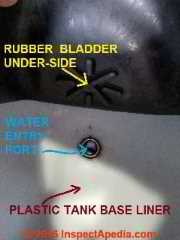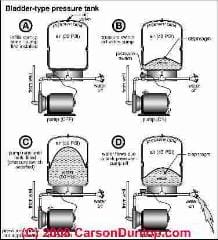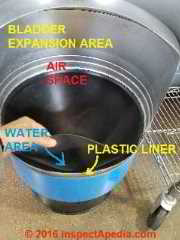 Water Pressure Tank Bladder Construction
Water Pressure Tank Bladder Construction
What are the parts of an internal-bladder water pressure tank?
- POST a QUESTION or COMMENT about water tanks that use an internal bladder
Internal bladder type water pressure tank construction details:
This article describes the parts that you might find inside of a typical internal-bladder type water tank if you could cut it apart. We using photographs, sketches & text we point out and explain the functions and features of each of the internal parts of the water tank, and we answer the question of where the air goes and where the water goes in these systems.
InspectAPedia tolerates no conflicts of interest. We have no relationship with advertisers, products, or services discussed at this website.
- Daniel Friedman, Publisher/Editor/Author - See WHO ARE WE?
Water Tank Bladder Construction & Parts
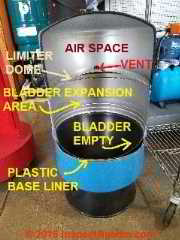 Reader comment: is the air in the bladder or is the water in the bladder in a water pressure tank?
Reader comment: is the air in the bladder or is the water in the bladder in a water pressure tank?
Your article on WATER TANK BLADDER PRESSURE ADJUSTMENT says:
" If the water tank bladder has developed a leak or has burst WATER WILL HAVE LEFT THE BLADDER and entered the air space in the tank making it difficult or even impossible to drain the tank completely.
That's because water that leaks into the tank's air chamber from a small hole in the tank bladder will not readily return to the bladder (water space) as you are draining the tank. "
Comment: There is nor supposed to be any water IN the bladder. The water comes in to the bottom of the steel tank and
PUSHES AGAINST the AIR BLADDER above it.
See diagrams here:
inspectapedia.com/water/Water-Tank-Bladders.php
Reply: the water is contained in a combined plastic liner (tank base) and bladder-underside (upper area of water reservoir) and air is above that space
[Click to enlarge any image]
Thanks for the head's up, James. In this article I have expanded the illustrations and clarified where water and air will be found, elaborating the explanation to include the case you cite. You're right that I needed to clarify the discussion.
Still, if there is any leak in the bladder, water can push through that leak, be it a pinhole or a tear, and then can enter the air space in the tank. Water will not readily return into the proper water area and the tank will both become water logged and have a shortened draw-down volume or ycle even though the system pressures will remain.
At the Ferreteria Don Pedro in San Miguel de Allende, I have just photographed a cutaway water pressure tank that will allow illustration of how these tanks work. There are, of course, other water pressure tank designs. But the case you cite is pretty standard.
Our image above shows the air and water space inside of a typical internal-bladder type water pressure tank. This tank actually has three distinct areas that I'll name from bottom-up:
- The Base Liner, pvc plastic-lined lower water tank portion into which water flows via a port in the tank bottom (not visible in the photo)
- The Bladder, a flexible rubber bladder that is pressed upwards by water entering the tank at tank bottom and is pressed downwards by air pressure in the two upper chambers of the tank.
The rubber bladder and plastic base liner are sealed together by a ring that holds the bladder in place in this design. Other water pressure tank designs may eschew the plastic base liner, sending water into or allowing water to drain out of a flexible rubber bladder alone. - Air Space, including a space below as well as space above the limiter dome; above the dome is an upper air-only chamber into which air may be forced when the bladder is fully-extended with water. Air moves through a vent opening to pass between the "air only" space above the limiter dome and the bladder expansion area (below the limiter dome) as water passes into or out of the water reservoir area in the tank bottom.
Above: I'm lifting the edge of the flexible rubber tank bladder that is currently in its fully collapsed or "concave" position. In this position the tank will be virtually empty of water. Below my hand you can see the light-colored edge of the plastic liner that will contains water in the bottom area of the tank when the pump sends water in.
As water enters the pressure tank it will push the rubber bladder upwards into a convex position. When the tank is completely full, water will be contained in the lower 2/3 of the tank in the space that is lined in its lower half by plastic and in its upper half by the now convex rubber bladder.
When the water tank is full, air above the bladder will have been pushed into the upper area of the tank. The purpose of the convex metal shell at the bottom of the upper tank area is to prevent over-expansion and tearing of the rubber bladder as water is sent into the tank by the water pump. The black button in the center of that convex metal shell is an air port that allows air to move between the space above the bladder when the tank is empty of water and the space above the shell as the bladder pushes upwards while water is entering the pressure tank.
In the photo below I've lifted the rubber tank bladder from its empty position to show both the white plastic liner of the water tank base and the round opening in the tank bottom thorough which water will enter the pressure tank.
To be clear, if an internal bladder collapses and tears this can prevent water from entering the pressure tank. And when the bladder is punctured or torn, water can enter the space that normally contains only air.
The water pressure tank sketches shown here were provided courtesy of Carson Dunlop Associates, a Toronto home inspection & education company.
Question: is the water in the bladder or is it air that's in the bladder
 (Aug 3, 2016) James said:
(Aug 3, 2016) James said:
Your article says:
f the water tank bladder has developed a leak or has burst WATER WILL HAVE LEFT THE BLADDER and entered the air space in the tank making it difficult or even impossible to drain the tank completely. That's because water that leaks into the tank's air chamber from a small hole in the tank bladder will not readily return to the bladder (water space) as you are draining the tank.
Comment: There is nor supposed to be any water IN the bladder. The water comes in to the bottom of the steel tank and PUSHES AGAINST the AIR BLADDER above it.
See diagrams here: WATER TANK BLADDERS & CAPTIVE AIR of water coming in bottom and pushing against the BLADDER which has charge of air in it.
This question was originally posted at WATER TANK AIR PRESSURE ADJUSTMENT
Reply: designs vary. In this design water is in a half-plastic, half-rubber container and air is in a half rubber-half steel container of the pressure tank
Thank you James, you're right. We've clarified and illustrated your point.
Water tank designs vary on the point of whether it's the air or the water that is contained inside of a rubber bladder.
In the illustration above, water enters at the bottom of this pressure tank and is contained in a hybrid chamber: the chamber bottom consists of a plastic liner. The chamber upper half consists of a rubber bladder, shown collapsed in my photo. When the water chamber is filled the water is contained in a half rigid-plastic and half flexible rubber container bonded together at their center meeting point.
Air is contained above the rubber bladder - more properly a diaphragm in this case, and is thus in a space that is half coated steel and half rubber.
Diagnose Recurrent Water Pressure Tank Bladder Failures vs Tank Construction & Tank Selection
Question: Elbi water pressure tank failure investigation: is there a tank construction, selection, installation, or use problem?
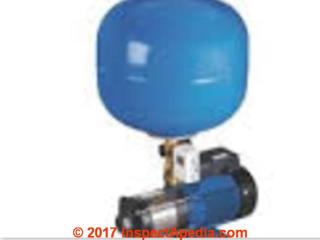 I have read with interest your treatise on failure management of booster pump pressure tanks with bladder. I am approaching you for guidance regarding the frequent premature failure of pressure tank in a 1 HP booster pump used in my residential home with 3 bathroom s. The make of pump is Crompton India and the make of pressure tank is Elbi-Italy. Picture of Pump is provided below:
I have read with interest your treatise on failure management of booster pump pressure tanks with bladder. I am approaching you for guidance regarding the frequent premature failure of pressure tank in a 1 HP booster pump used in my residential home with 3 bathroom s. The make of pump is Crompton India and the make of pressure tank is Elbi-Italy. Picture of Pump is provided below:
I installed the pump in Jan 2016 which is on the side of the overhead tank in the open sun but covered with a FRP shelter which prevents direct sunlight and the green house cover in the terrace reduces the heat too by 50%. Max Atmospheric temperatur is 38 C during April 15-Jun 15 and 28-35 C for balance 10 months.
Earlier in 2009 I had purchased similar pump of Espa Spain make with another pressure tank, also an Italian make. Like the earlier pressure tank which failed every 2 years due to leak/burst, the new 2016 tank also failed but in 14 months, just 2 months after warranty expired.
I attach a picture of the failed tank bottom which shows 2 pin holes on the body of the tank 2 inches away from the male connector. Presumably water has collected inside vessel at the joint and the MS has got rusted and resulted in leak or as I read in your treatise there has been a pin hole in the bladder which has caused the hole in MS shell. This was accompanied by rapid drop in pressure and more frequent restart of the pump.
Happily the supplier replaced with a new pressure tank which cost me nearly 30% of pump cost- they always fleece customers while selling spares. Based on previous experience over 7 years I had taken care to install an online filter ( 5 PPM 3M Filter-as expensive as the pump !) to ensure water quality is good and the fine suspended particles which can blast-puncture the bladder are eliminated. Yet the tank failed in 14 months while the other Italian brand lasted 2 years.
I would be grateful if you can advise what causes such frequent failure? Is it the wrong choice of bladder material ? Frankly I do not know the material used. I have read EPDM and Butyl Synth Rubber bladders withstand 90-100C ( in any case it is not hot water here but only water from OHT heated by Sunshine at 30-38C). I have also read FRP tanks do not rust and are preferred over MS
Thanks in advance. - Anonymous by private email 2017/04/07
Reply: things to check: tank selection of type, model, size vs water pressure tank requirements & type of water system in use
Elbi offers replacement water pressure tank bladders and INSTRUCTIONS for ANK BLADDER REPLACEMENT for 8-45L tanks - for which we provide a copy of the company's PDF document, retrievedf 2017/04/08, original source: http://www.elbi.net/wp-content/uploads/2015/07/Elbi-Replacement-Bladder-Procedure-8ltr-thru-45-ltr.pdf - we give contact information for Elbi below.
But that doesn't address the early failure of your system.
I proceed by asking for more information that might help us diagnose the problem?
1. I'd like to see some photos of your water system with tank and pump as it is installed.
2. Can you tell me the operating pressure range of your water system?
3. Have you made a magnified examination of the area of tank bladder failure (the pinholes you cite) AND of the corresponding tank surfaces against which the bladder is forced during use? I'd look for welding spatter or any other sharp surface properties or even just debris in the tank.
4. Can you tell me the specific model of your Elbi water tank. It's possible that the tank you are using is either not the correct model, OR as a second line of thought it may be too small for the water volume you are using.
Looking at the company's website http://www.elbi.net/product-category/residential-diaphragm-tanks/ for residential diaphraghm-type pressure tanks, you should be using a DWT-series pressure tank. Your photos don't look like any of those, but I may not be finding the company's full product line. A tank the size of the one in your photo would be perhaps a 2-gallon DWT-8-RO8
I'd also like to know how your water system works. Here in Mexico we use a pressure-boosting water pump that boosts pressure from a rooftop water storage tank or cistern; those systems often use a very small pressure tank, sometimes one built right into the pump.
More-conventional pump and well systems use a larger water pressure tank in part because the pump and tank are not designed for very frequent on-off cycling nor for very long continuous pump-on cycles.
Or using the wrong tank could be a cause of tank bladder failure. Not suitable, for example would be their XT / XTV series are intended for use in hot water solar, glycol-protected systems (not that you probably need that in India) and are not intended for domestic water systems.
Contact Elbi Water Tanks
5. Have you tried asking Elbi technical support what is the anticipated life of the tank you are using? Try sending an e-mail to info@elbi.it .
- Elbi Italy direct is at http://www.elbi.it/ Elbi S.p.A. | Via Buccia 9 | 35010 Limena (PD) Italy | Tel +39 049 8840677 | Fax +39 049 8841610 | PIVA IT00838770287 Elbi SpA, Peel Street, 9 Limena (PD) I-35010 Italy Tel +39 049 8840677 - Fax +39 049 8841610 Email: info@elbi.it .
- Elbi Italy, at least when I try, insists on giving me a U.S. contact: http://eoa.elbi.it/staff/body.pe
U.S. readers are also given this Texas contact for Elbi
- Elbi of America, Inc., 15882 Diplomatic Plaza Suite 170, Houston, TX 77032-2669 USA, email: sales1@elbi.net Nicole Philip/Sales-customer service or sales2@elbi.net Makeda Williams/Sales-customer service, Tel: +1 713-674-2900, Website: http://www.elbi.net/
...
Continue reading at WATER TANK BLADDERS - topic home, or select a topic from the closely-related articles below, or see the complete ARTICLE INDEX.
Or see these
Recommended Articles
- WATER TANK BLADDER PRESSURE ADJUSTMENT
- WATER TANK BLADDER REPLACEMENT
- WATER TANK DIAGNOSIS & REPAIR - home
Suggested citation for this web page
WATER TANK BLADDER CONSTRUCTION at InspectApedia.com - online encyclopedia of building & environmental inspection, testing, diagnosis, repair, & problem prevention advice.
Or see this
INDEX to RELATED ARTICLES: ARTICLE INDEX to WATER SUPPLY, PUMPS TANKS WELLS & SPRINGS
Or use the SEARCH BOX found below to Ask a Question or Search InspectApedia
Ask a Question or Search InspectApedia
Try the search box just below, or if you prefer, post a question or comment in the Comments box below and we will respond promptly.
Search the InspectApedia website
Note: appearance of your Comment below may be delayed: if your comment contains an image, photograph, web link, or text that looks to the software as if it might be a web link, your posting will appear after it has been approved by a moderator. Apologies for the delay.
Only one image can be added per comment but you can post as many comments, and therefore images, as you like.
You will not receive a notification when a response to your question has been posted.
Please bookmark this page to make it easy for you to check back for our response.
IF above you see "Comment Form is loading comments..." then COMMENT BOX - countable.ca / bawkbox.com IS NOT WORKING.
In any case you are welcome to send an email directly to us at InspectApedia.com at editor@inspectApedia.com
We'll reply to you directly. Please help us help you by noting, in your email, the URL of the InspectApedia page where you wanted to comment.
Citations & References
In addition to any citations in the article above, a full list is available on request.
- [1] Rasmussen Well Drilling, Inc., 1793 Hwy 61, Two Harbors MN. Jeremy Rasmussen provides third generation well drilling and plumbing services on the North Shore of Lake Superior. Photos by DJF. Tel 218-834-3387. Email: rasmussenwell@frontier.com
Quoting: We serve the north Shore – Lake, Cook, St. Louis, Carlton and Pine counties, including Duluth, Grand Marais, Clouqet, Carlton, Finland, Isabella, Silver Bay, Grand Portage, Saginaw, and everywhere in Northeastern Minnesota. - [2] Well-Rite water tanks. Well-Rite water tanks are produced by Flexcon Industries, 300 Pond Street Randolph, MA 02368 Tel: 781.986.2424, based on manufacturer data provided on the shipping carton for a 44 Gallon / 170 Liter internal bladder water pressure tank during installation in Northern Minnesota, September 2011.
- Thanks to Jeremy Houser who suggested that we needed to clarify the difference between bladder type and non-bladder type water tanks when discussing air charging and diagnosis of water tank repairs.
- Thanks to reader Steven Prior for discussing water pressure tank location, water filter location, and for the water tank air valve photo - July 2010.
- Amtrol Extrol™ pressure control tanks used on hydronic heating and other systems such as models 35LBC, 50 LBC, 85 LBC, and 100LBC to 600 LBC also use a bottom bladder containing air - see amtrol.com/pdf/LBCSeriesEXTROL9017-095.pdf for details.
- Mark Cramer Inspection Services Mark Cramer, Tampa Florida, Mr. Cramer is a past president of ASHI, the American Society of Home Inspectors and is a Florida home inspector and home inspection educator. Mr. Cramer serves on the ASHI Home Inspection Standards. Contact Mark Cramer at: 727-595-4211 mark@BestTampaInspector.com
- John Cranor [Website: /www.house-whisperer.com ] is an ASHI member and a home inspector (The House Whisperer) is located in Glen Allen, VA 23060. He is also a contributor to InspectApedia.com in several technical areas such as plumbing and appliances (dryer vents). Contact Mr. Cranor at 804-873-8534 or by Email: johncranor@verizon.net
- Thanks to Jeff Garmel for discussing clarifications on water pressure tank testing and diagnosis, 8/24/2009.
- Thanks to Bill Kortebein for discussing dealing with a water-logged collapsed bladder water pressure tank 07/24/2010
- Rasmussen Well Drilling, Inc., 1793 Hwy 61, Two Harbors MN. Jeremy Rasmussen provides third generation well drilling and plumbing services on the North Shore of Lake Superior. Photos by DJF. Tel 218-834-3387. Email: rasmussenwell@frontier.com
Quoting: We serve the north Shore – Lake, Cook, St. Louis, Carlton and Pine counties, including Duluth, Grand Marais, Clouqet, Carlton, Finland, Isabella, Silver Bay, Grand Portage, Saginaw, and everywhere in Northeastern Minnesota. - Wessels Company bladder replacement store was found at westank.com/bladder-tank-store.php on 5/22/2009. Wes sell refers to "shock and surge tanks" as ASME replaceable bladder type and pre-charged hydropneumatic tanks used for commercial, industrial, and well water systems.
- Well-Rite water tanks. Well-Rite water tanks are produced by Flexcon Industries, 300 Pond Street Randolph, MA 02368 Tel: 781.986.2424, based on manufacturer data provided on the shipping carton for a 44 Gallon / 170 Liter internal bladder water pressure tank during installation in Northern Minnesota, September 2011.
- Our recommended books about building & mechanical systems design, inspection, problem diagnosis, and repair, and about indoor environment and IAQ testing, diagnosis, and cleanup are at the InspectAPedia Bookstore. Also see our Book Reviews - InspectAPedia.
- In addition to citations & references found in this article, see the research citations given at the end of the related articles found at our suggested
CONTINUE READING or RECOMMENDED ARTICLES.
- Carson, Dunlop & Associates Ltd., 120 Carlton Street Suite 407, Toronto ON M5A 4K2. Tel: (416) 964-9415 1-800-268-7070 Email: info@carsondunlop.com. Alan Carson is a past president of ASHI, the American Society of Home Inspectors.
Thanks to Alan Carson and Bob Dunlop, for permission for InspectAPedia to use text excerpts from The HOME REFERENCE BOOK - the Encyclopedia of Homes and to use illustrations from The ILLUSTRATED HOME .
Carson Dunlop Associates provides extensive home inspection education and report writing material. In gratitude we provide links to tsome Carson Dunlop Associates products and services.


